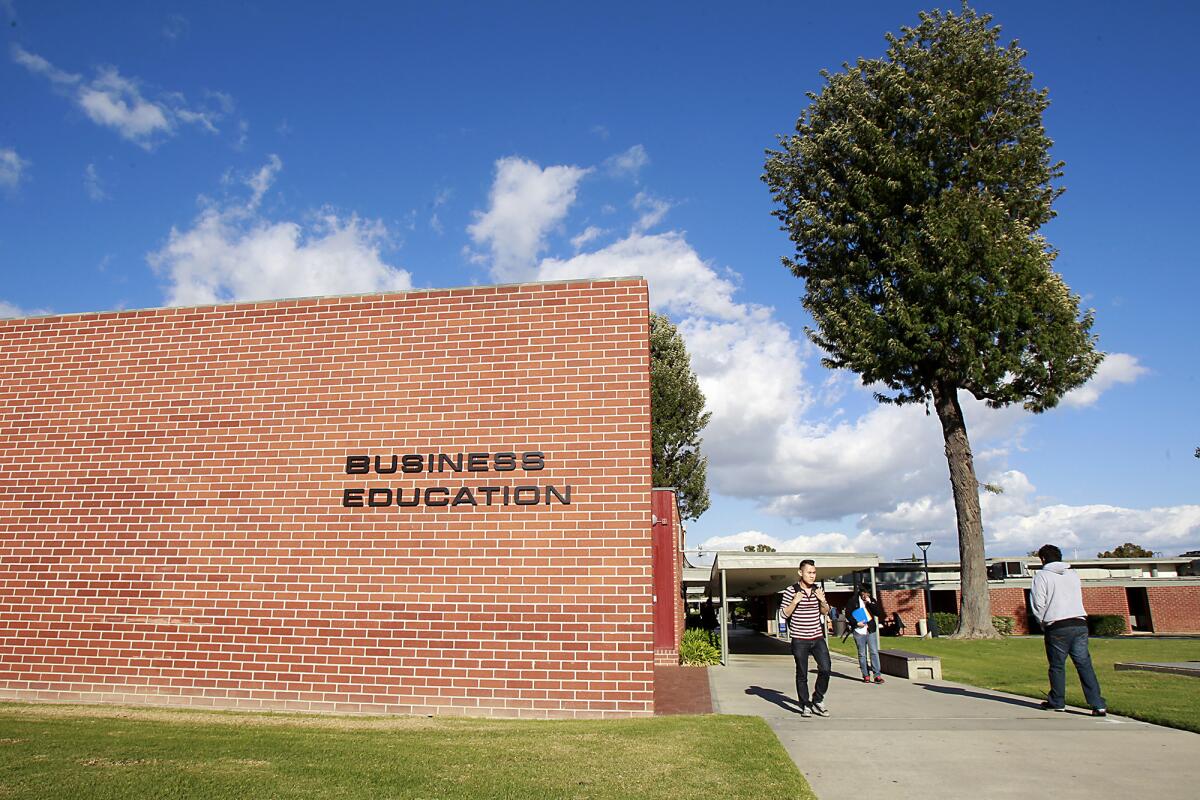Plan bumps up against history

- Share via
Orange Coast College has undergone many transformations in its 65-year history — buildings have been demolished and remodeled and others have been built in their place — mostly without significant controversy.
However, as the college approaches yet another milestone in construction, rapidly moving forward with its Vision 2020 plan for campus development, some longtime faculty members are raising concerns about the removal of buildings designed by world-renowned architect Richard Neutra.
“We can always build new buildings, but to me they are proposing to tear the heart and core out of the Orange Coast College campus,” said Dennis Kelly, a former marine science professor at OCC.
Neutra was an Austrian-born modern architect hired in the late 1940s to transform a former Costa Mesa military base into OCC. He previously worked for Frank Lloyd Wright.
He boasted a noteworthy resume in Orange County and Los Angeles, with homes featuring large windows and sliding glass doors based on his philosophy of dissolving the artificial barrier between the inside and the outside. It was a vision he kept in mind at OCC as well.
The architect designed the still-standing planetarium, business education, reprographics and speech arts buildings — the later now known as the Robert B. Moore theatre — and the football stadium.
The business education building has staggered walls, which not only protect classrooms from the elements but also allow a breeze to flow into the rooms, keeping them cool in the summer, Kelly said.
Many of the buildings also feature large opening windows in the rear of the classrooms that allow natural light to fill the space.
“A lot of the new buildings don’t have windows, so you can’t look out on the world,” Kelly said. “Neutra’s buildings are structures with human perspective. They’re not massive buildings, which tend to alienate people from the world around them.”
However, as the campus population continues to grow and technology advances from the 1950s, the college district’s administration has refocused its vision to a campus that boasts a central quad and multistory buildings surrounding the perimeter, said Richard Pagel, vice president of administrative services.
Much to the chagrin of preservationists like Kelly, the district’s Vision 2020 master plan proposes demolishing several Neutra buildings, including business education, the planetarium and reprographics.
Removing buildings, many of which are Neutra’s designs, in the center of the campus provides the college with more flexibility for future campus expansion, Pagel said.
“When you open up the center of campus, it gives you an opportunity to look 50 years down the road,” he said. “Those 1950s structures are great, but they are 1950s structures. They’re tired structures.”
However, Kelly said the district shouldn’t be so quick to tear down pieces of the college’s history.
“Once it’s gone, it’s gone forever,” he said.
The first Neutra building slated for removal, in 2015, is the planetarium.
A new, larger planetarium will feature updated technology and more learning space, Pagel said.
The district hired a historian over the summer to analyze the effect that removing the buildings would have on the campus, Pagel said.
“We always knew we had historical buildings on campus,” he said. “Before we take out any building we need to look at the historical significance.”
The district is also working to comply with the California Environmental Quality Act, which requires state and local agencies to identify the significant environmental effects of construction projects and avoid them, if possible.
The process will also allow preservationists, like Kelly and Barbara Lamprecht, an architectural historian, to voice their concerns about the direction of campus planning.
In a November letter to district and college officials, Lamprecht suggested that OCC consider rehabilitating instead of removing Neutra buildings.
“Orange Coast College can be proud to possess such a rare example by such important figures,” she wrote. “No other American community college or even four-year university possesses such a carefully conceived ‘landscape for learning.’”
However, Pagel suggests the situation isn’t black and white. The college is receiving money from the state to construct new buildings on campus, and thus old buildings must be removed.
“We couldn’t put up all the new buildings and not take down the old ones,” he said. “If we don’t start to demonstrate that we intend to move those older buildings, then the state funding could stop.”